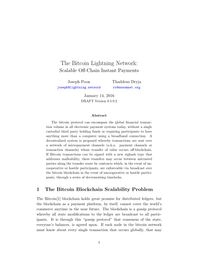
1 The Bitcoin Blockchain Scalability Problem
The Bitcoin blockchain holds great promise for distributed ledgers, but
the blockchain as a payment platform, by itself, cannot cover the world’s
commerce anytime in the near future. The blockchain is a gossip protocol
whereby all state modifications to the ledger are broadcast to all participants.
It is through this “gossip protocol” that consensus of the state,
everyone’s balances, is agreed upon. If each node in the bitcoin network
must know about every single transaction that occurs globally, that may
create a significant drag on the ability of the network to encompass all
global financial transactions. It would instead be desirable to encompass all
transactions in a way that doesn’t sacrifice the decentralization and security
that the network provides.
The payment network Visa achieved 47,000 peak transactions per second (tps)
on its network during the 2013 holidays, and currently averages
hundreds of millions per day. Currently, Bitcoin supports less than 7 transactions
per second with a 1 megabyte block limit. If we use an average of 300
bytes per bitcoin transaction and assumed unlimited block sizes, an equivalent
capacity to peak Visa transaction volume of 47,000/tps would be nearly
8 gigabytes per Bitcoin block, every ten minutes on average. Continuously,
that would be over 400 terabytes of data per year.
Clearly, achieving Visa-like capacity on the Bitcoin network isn’t feasible today.
No home computer in the world can operate with that kind of
bandwidth and storage. If Bitcoin is to replace all electronic payments in
the future, and not just Visa, it would result in outright collapse of the Bitcoin
network, or at best, extreme centralization of Bitcoin nodes and miners
to the only ones who could afford it. This centralization would then defeat
aspects of network decentralization that make Bitcoin secure, as the ability
for entities to validate the chain is what allows Bitcoin to ensure ledger
accuracy and security.
Having fewer validators due to larger blocks not only implies fewer
individuals ensuring ledger accuracy, but also results in fewer entities that
would be able to validate the blockchain as part of the mining process,
which results in encouraging miner centralization. Extremely large blocks,
for example in the above case of 8 gigabytes every 10 minutes on average,
would imply that only a few parties would be able to do block validation.
This creates a great possibility that entities will end up trusting centralized
parties. Having privileged, trusted parties creates a social trap whereby
the central party will not act in the interest of an individual (principalagent
problem), e.g. rentierism by charging higher fees to mitigate the
incentive to act dishonestly. In extreme cases, this manifests as individuals
sending funds to centralized trusted custodians who have full custody of
customers’ funds. Such arrangements, as are common today, create severe
counterparty risk. A prerequisite to prevent that kind of centralization from
occurring would require the ability for bitcoin to be validated by a single
The Bitcoin Lightning Network: Scalable Off-Chain Instant Payments




